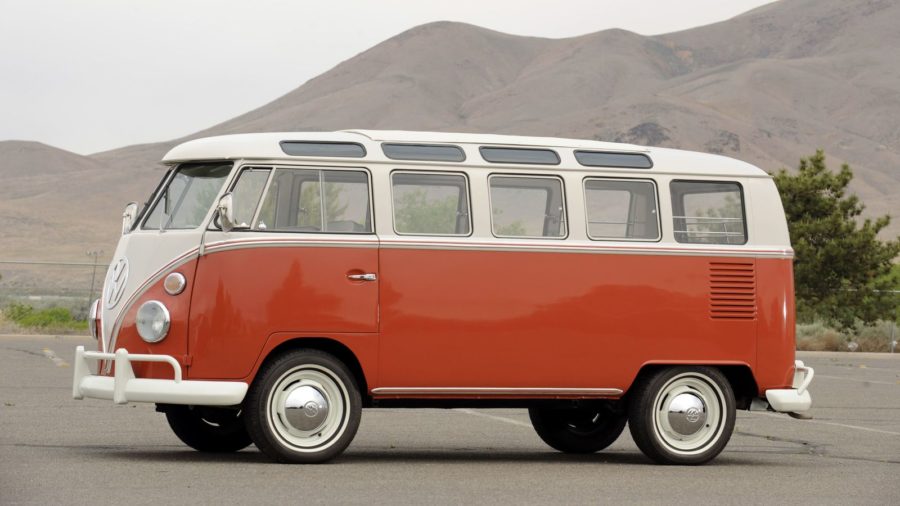Wolfsburg Cream Sickle – inspired by VW’s Type 2
hover and click over individual sculpture photographs to enlarge
THE CAR

https://www.popularmechanics.com/cars/trucks/a26207/volkswagen-microbus-vw-bus/
Everyone smiles when they see a VW “Type 2” van. The more windows, the bigger the smile. The Type 2 certainly wasn’t fast, but it was versatile and reliable. Owners loved them. Being a VW owner in the 1950s and 1960s was the equivalent of being an Apple owner 20 years ago, or perhaps a Tesla owner today. You marched defiantly to a different drummer.
I’ve been looking forward to the opportunity to sculpt my tribute to the legions of air-cooled VW fans. The fans seem as passionate today as I remember them in-period. My mother and father had an early “small-window” VW Beetle before I was born. Dad almost took the plunge to be a VW salesman, but ended up selling other wares.
Growing up in suburbia, my exposure to VWs was typically as some other family’s second car. I recall the Beetle competing against small French and British cars in the late 1950s and early 1960s. The Beetle’s engine noise was unmistakable, if not overly-inspiring.
Come my early college days, the year I lived on-campus, Rob was the only one in our group who had a car. He loved his yellow Super Beetle, and we all loved the available transportation. Chipping in for gas was cheap too. I hope you are well Rob, wherever you are.
Later in my college days, I worked part-time at a specialty used car dealer. Our usual fare were BMWs, Porsches, Jags, Alfas and MGs. An older, but mint, VW Westphalia camper van came through the lot. The owner of the dealership was kind enough to lend the van to me for a long-weekend camping trip with a young lady friend.
Driving a Type 2 meant thinking ahead of any incline of how to stay out-of-the-way of traffic. Having to stop often to soap up the noisy engine fan belt was another novel VW idiosyncrasy. Once the Westphalia got to the camping ground, it excelled for two.
Then, later in my university career, while training in New Zealand, another young lady with a two-toned 1966 VW Bug named Trudi (the car, not the young lady) found me. If you hustled Trudi through the corners the chassis had enough flex that the outside door could unlatch itself and fly open. Thankfully, someone had installed lap belts in this 1966 VW.
So, I’ve got close to drinking the VW Kool-Aid, but I never owned one. We can infer the esteem a model is held from the nature and number of its nickname(s). Consider for just the Type 2, Kombi, microbus, hippie van and Samba.
I’ll assume readers know the basics of the pre-war Bug story, with its design by independent consultant engineer Dr. Ferdinand Porsche. The new plant the Reich built at Wolfsburg produced very few cars from May 1938, before converting to war needs.
Post-war Wolfsburg was in the British-controlled administrative area of West Germany. The British knew affordable transportation would be needed for the recovery of the German economy. They had control of the bombed-out government-owned VW plant. Unemployment was staggering.
Some Brit with William Shatner-like charisma said “make it so”, and the crew did. Over the next decade, more than a million cars would be Wolfsburg-produced. The German government held the IPO sale of company stocks in 1960. Seventy years later Wolfsburg is still the largest car plant in the world.
Ben Pon had become the Dutch importer for VW by 1949. He is generally credited with originating the Type 2 Van concept, and was the catalyst for the first prototypes. The engine power available in 1949 was far less than even my borrowed Westphalia’s. To mitigate that limitation, the Type 2 prototypes were sent to the University of Berlin wind-tunnel for aerodynamic improvements.
(Ben Pon comes up again in my sculpting, see the Ping Pon Porsche 904 sculpture, https://kellensilverthornsculptures.com/sculptures/ping-pon/).
Though the Type 2 ended up with the same wheelbase as the Bug, it is not the same chassis. The Type 2 is built to a 750 kg / 1650 lb load carrying capacity. As well, while the Bug is a form of body-on-frame, the Kombi is more towards a unibody construction.
The Samba won the hearts of many tradesmen, merchants, tourists, and parents with large families. In the latter 1960s it was also the poster-child for the counter-culture of drugs, sex, and rock n’ roll. Trekking to Woodstock in your VW hippie van would have been the zenith of it all. Unfortunately, I was six years behind all that, and when I did come of age, then in a V8-powered tri-tricolor Econoline 100 shaggin’ wagon — but that’s a story for another sculpture.
Since the replacement of the air-cooled VWs in the developed world in the mid-1970s, VW has looked for ways to recapture the Kool-Aid effect of the Beetle and Type 2, with some success. We may have to wait for the electric I.D. Buzz model from VW to recapture the Type 2 microbus’ allure.
THE STONE
The “cream” in the Wolfsburg Cream Sickle is Statuario marble from Carrera, Italy. This is the same marble figurative sculptors use for their nudes, or cupids …. Yes, even that Michelangelo guy with young David. The stuff (the stone) is a dream to sculpt. Most sculptors prefer the “matte with sparkles” appearance you acheive with Statuario at 100-300 grit finish.
The orange in the Cream Sickle is orange calcite from Utah, USA. Calcite, along with dolomite, are the main divisions of the marble family.
Orange calcite has several interesting properties. When thick and polished, orange calcite is opaque with a waxy or even plastic-appearing finish. When thinner and polished, it becomes more yellow, more translucent, and less waxy in its finished appearance. For sculptures that are not overly large, under lighting can add a lava lamp-like dimension, aiding in the cream sickle motif.







